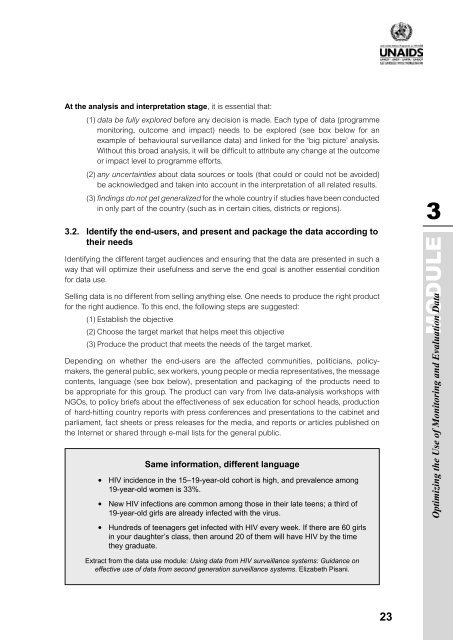Monitoring and Evaluation Modules - Global HIV M&E Information
Monitoring and Evaluation Modules - Global HIV M&E Information
Monitoring and Evaluation Modules - Global HIV M&E Information
Create successful ePaper yourself
Turn your PDF publications into a flip-book with our unique Google optimized e-Paper software.
At the analysis <strong>and</strong> interpretation stage, it is essential that:<br />
(1) data be fully explored before any decision is made. Each type of data (programme<br />
monitoring, outcome <strong>and</strong> impact) needs to be explored (see box below for an<br />
example of behavioural surveillance data) <strong>and</strong> linked for the ‘big picture’ analysis.<br />
Without this broad analysis, it will be difficult to attribute any change at the outcome<br />
or impact level to programme efforts.<br />
(2) any uncertainties about data sources or tools (that could or could not be avoided)<br />
be acknowledged <strong>and</strong> taken into account in the interpretation of all related results.<br />
(3) findings do not get generalized for the whole country if studies have been conducted<br />
in only part of the country (such as in certain cities, districts or regions).<br />
3.2. Identify the end-users, <strong>and</strong> present <strong>and</strong> package the data according to<br />
their needs<br />
Identifying the different target audiences <strong>and</strong> ensuring that the data are presented in such a<br />
way that will optimize their usefulness <strong>and</strong> serve the end goal is another essential condition<br />
for data use.<br />
Selling data is no different from selling anything else. One needs to produce the right product<br />
for the right audience. To this end, the following steps are suggested:<br />
(1) Establish the objective<br />
(2) Choose the target market that helps meet this objective<br />
(3) Produce the product that meets the needs of the target market.<br />
Depending on whether the end-users are the affected communities, politicians, policymakers,<br />
the general public, sex workers, young people or media representatives, the message<br />
contents, language (see box below), presentation <strong>and</strong> packaging of the products need to<br />
be appropriate for this group. The product can vary from live data-analysis workshops with<br />
NGOs, to policy briefs about the effectiveness of sex education for school heads, production<br />
of hard-hitting country reports with press conferences <strong>and</strong> presentations to the cabinet <strong>and</strong><br />
parliament, fact sheets or press releases for the media, <strong>and</strong> reports or articles published on<br />
the Internet or shared through e-mail lists for the general public.<br />
Same information, different language<br />
• <strong>HIV</strong> incidence in the 15–19-year-old cohort is high, <strong>and</strong> prevalence among<br />
19-year-old women is 33%.<br />
• New <strong>HIV</strong> infections are common among those in their late teens; a third of<br />
19-year-old girls are already infected with the virus.<br />
3<br />
MODULE<br />
Optimizing the Use of <strong>Monitoring</strong> <strong>and</strong> <strong>Evaluation</strong> Data<br />
• Hundreds of teenagers get infected with <strong>HIV</strong> every week. If there are 60 girls<br />
in your daughter’s class, then around 20 of them will have <strong>HIV</strong> by the time<br />
they graduate.<br />
Extract from the data use module: Using data from <strong>HIV</strong> surveillance systems: Guidance on<br />
effective use of data from second generation surveillance systems. Elizabeth Pisani.<br />
23















